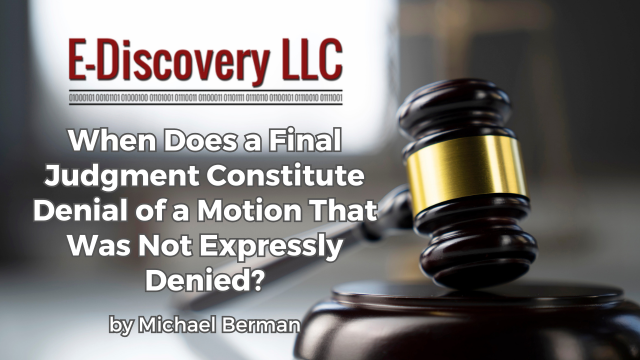
[EDRM Editor’s Note: The opinions and positions are those of Michael Berman.]
Mr. Escobar-Salmeron sued several correctional officers alleging excessive force. Defendants moved for summary judgment.
Plaintiff filed a Fed.R.Civ.P. 56(d) motion1 for more time to conduct discovery before responding to the summary judgment motion. The district court did not rule on the plaintiff’s Rule 56(d) motion, but granted a final summary judgment for defendants. That final judgment was construed as a denial of the Rule 56(d) “discovery challenge.” Escobar-Salmeron v. Moyer, __ F. 4th __, 2025 WL 2348707 (4th Cir. Sep. 24, 2025).
In Escobar-Salmeron, the Fourth Circuit enunciated the standard for determining when a final judgment constitutes denial of “any outstanding motions” that the District Court had not ruled on. The Court wrote:
Absent evidence of accidentally overlooking the motion, “[w]hen a district court enters a final judgment, it has implicitly denied any outstanding motions, even if the court does not explicitly deny a particular motion.”
Id. at *7 (emphasis added).
Escobar-Salmeron importantly holds that “any outstanding motions,” including discovery motions, are implicitly denied by a final judgment, “[a]bsent evidence of accidentally overlooking the motion….”
However, in Escobar-Salmeron, the Court held the implicit denial of the procedural motion was proper on the facts presented. On the merits, the Court vacated and remanded the grant of summary judgment, finding a genuine dispute of material fact as to the alleged use of excessive force.
Plaintiff contended that he was strip-searched and brutally beaten. “The Correctional Officers disputed Escobar-Salmeron’s compliance with the strip search, his injuries, and the sequence of events through which the confrontation turned physical.” Id. at *1.
The District Court held that on the undisputed facts, there was no evidence of malicious or sadistic action. Id. Plaintiff appealed the grant of summary judgment. Viewing the facts most favorable to the non-moving party, the Fourth Circuit vacated and remanded.
After reciting the prefatory facts, the Court wrote that: “The Correctional Officers then escorted both men [Mr. Escobar-Salmeron and another inmate] to the Day Room. At this point, the parties’ stories diverge.” Id. at *1.
In a nutshell, the officers reported: non-compliance; concerns about a hidden knife; finding a 6 ¾” knife; biting; and, a struggle. In response and briefly summarized, Mr. Escobar-Salmeron swore to: prompt compliance with orders; being forced to the floor without cause; kicking; repeated punching, even after being handcuffed; and, choking by the officers. He stated that he bit the officer only because the officer was choking him. The Court wrote that: “The Correctional Officers’ stories vary about how exactly [Correctional Officer] Arndt assisted Holland.” Id. at *2.
A subsequent internal investigation determined that “there was no evidence found to substantiate [Escobar-Salmeron’s] claim that he was assaulted,” and “[t]here was no incident of excessive force.” Mr. Escobar-Salmeron was found guilty of assault. Id. at *5.
Plaintiff sued. When defendants moved for summary judgment on plaintiff’s 42 U.S.C. §1983 claim, “Escobar-Salmeron opposed the motion, citing Fed. R. Civ. P. 56(f) to argue summary judgment should be denied because he had been unable to pursue discovery.” Id. at *5.
The Court explained that Rule 56(f) is now Rule 56(d). Id. at n. 4. Rule 56(d) states:
(d) When Facts Are Unavailable to the Nonmovant. If a nonmovant shows by affidavit or declaration that, for specified reasons, it cannot present facts essential to justify its opposition, the court may:
(1) defer considering the motion or deny it;
(2) allow time to obtain affidavits or declarations or to take discovery; or
(3) issue any other appropriate order. [emphasis added].
Rule 56(d).
When the District Court dismissed the state-law claims and entered summary judgment for the defendants on the §1983 claims, it did not address Mr. Escobar-Salmeron’s Rule 56(d) motion.
The Fourth Circuit wrote: “We begin by addressing Escobar-Salmeron’s Rule 56(d) discovery challenge.” Id. at *6 (emphasis added). It explained that Rule 56(d) motions “must be granted where the nonmoving party has not had the opportunity to discover information that is essential to his opposition.” Id. (cleaned up).
After discussing the standard for such motions, the Fourth Circuit wrote: “Circuits disagree as to whether a court must explicitly acknowledge a Rule 56(d) declaration.” Id. at *7. The discovery requested, but not available to Mr. Escobar-Salmeron was the video of what happened in the “day room.” That video was exclusively in defendants’ possession. Id.
Mr. Escobar-Salmeron “argues that the district court’s failure to explicitly address his declaration was itself error.” Id. at *7. The defendants did not address that point and, instead, argued that plaintiff had failed to request discovery or move to compel. Id. The Fourth Circuit held that the District Court had implicitly denied the Rule 56(d) request:
As a threshold matter, we agree with the Fifth and Ninth Circuits that district courts need not directly address an outstanding Rule 56(d) motion. Absent evidence of accidentally overlooking the motion, “[w]hen a district court enters a final judgment, it has implicitly denied any outstanding motions, even if the court does not explicitly deny a particular motion.” See Snider, 946 F.3d at 667–68. Because Escobar-Salmeron has presented no evidence that the district court overlooked his Rule 56(d) declaration, we interpret the district court’s silence as a denial.
Id. at *7 (emphasis added).
As a threshold matter, we agree with the Fifth and Ninth Circuits that district courts need not directly address an outstanding Rule 56(d) motion. Absent evidence of accidentally overlooking the motion, “[w]hen a district court enters a final judgment, it has implicitly denied any outstanding motions, even if the court does not explicitly deny a particular motion.”
Escobar-Salmeron v. Moyer, __ F. 4th __, 2025 WL 2348707 at *7 (4th Cir. Sep. 24, 2025) (emphasis added).
However, on the substantive merits of the Rule 56(d) motion, plaintiff fell short: “Regarding Escobar-Salmeron’s Rule 56(d) motion, we find his request procedurally insufficient.” Id. The Court held that he had failed to request discovery and failed to identify additional evidence with sufficient particularity. Id. It distinguished unpublished precedent where the “declaration was significantly more detailed than Escobar-Salmeron’s declaration.” Id. at *8. Because Mr. Escobar-Salmeron’s Rule 56(d) request was “vague,” the District Court did not abuse its discretion by granting summary judgment “despite his Rule 56(d) declaration.” Id.
Turning to the merits of the excessive force claim: “Finding genuine disputes of material fact remain, we vacate the district court’s decision and remand for further proceedings.” Id. “Viewing the record in the light most favorable to Escobar-Salmeron, we find that material facts remain in dispute.” Id. at *9.
While Escobar-Salmeron involved a Rule 56(d) “discovery challenge,” the Court’s statement applies to “any outstanding motions.”
Notes
- The Court variously described Mr. Escobar-Salmeron’s Rule 56(d) effort as a declaration, “discovery challenge,” and “Escobar-Salmeron’s Rule 56(d) motion….” Id. at *7 (emphasis added). ↩︎
Assisted by GAI and LLM Technologies per EDRM GAI and LLM Policy.


